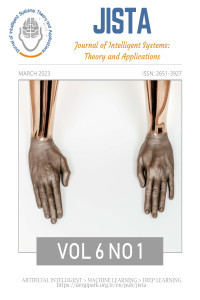Artificial intelligence in corneal topography
Artificial intelligence in corneal topography
The purpose of this paper is to explore the effectiveness and efficiency of various artificial intelligence (AI) techniques in extracting features from corneal topographies. A considerable number of dated and contemporary related research papers have been reviewed. The author has only checked the studies that considered developing at least one AI-based algorithm for data classification of topographic patterns. The results of this review emphasize the effectiveness and efficiency of machine learning algorithms in the clinical diagnosis of various eye refractive problems.
___
- Arbelaez, M. C., Versaci, F., Vestri, G., Barboni, P., & Savini, G. (2012). Use of a support vector machine for keratoconus and subclinical keratoconus detection by topographic and tomographic data. Ophthalmology, 119(11), 2231–2238. https://doi.org/10.1016/j.ophtha.2012.06.005
- Bagherinia, H., Chen, X., Flachenecker, C., Angeles, R., Burger, D., Caroline, P., … Reeder, K. (2008). Support Vector Machine (SVM)-Based Classification of Corneal Topography. Investigative Ophthalmology & Visual Science, 49(13), 1023. Retrieved from http://dx.doi.org/
- Camarillo, T., Choi, K., Hamilton, G., Miles, M., Muller, K., Williams, K., … Schrepel, P. (2002). Athletes as an Ideal Target Population for Orthokeratology Keratoconus : Improving Quality of Life Through Advancements in Detection and Treatment.
- Carvalho, L. A. (2005). Preliminary Results of Neural Networks and Zernike Polynomials for Classification of Videokeratography Maps: Optometry and Vision Science, 82(2), 151–158. https://doi.org/10.1097/01.OPX.0000153193.41554.A1
- de Carvalho, L. A., & Barbosa, M. S. (2008). Neural networks and statistical analysis for classification of corneal videokeratography maps based on Zernike coefficients: a quantitative comparison. Arquivos Brasileiros de Oftalmologia, 71(3), 337–341. Retrieved from http://www.ncbi.nlm.nih.gov/pubmed/18641817
- Kabari, L., & Nwachukwu, E. (2012). Neural Networks and Decision Trees For Eye Diseases Diagnosis. In P. Vizureanu (Ed.), Advances in Expert Systems. InTech.
- Kermany, D. S., Goldbaum, M., Cai, W., Valentim, C. C. S., Liang, H., Baxter, S. L., … Zhang, K. (2018). Identifying Medical Diagnoses and Treatable Diseases by Image-Based Deep Learning. Cell, 172(5), 1122–1131.e9. https://doi.org/10.1016/j.cell.2018.02.010
- Kotsia, I., & Pitas, I. (2007). Facial Expression Recognition in Image Sequences Using Geometric Deformation Features and Support Vector Machines. IEEE Transactions on Image Processing, 16(1), 172–187. https://doi.org/10.1109/TIP.2006.884954
- Kurniawan, R., Yanti, N., & Ahmad Nazri, M. Z. (2014). Expert systems for self-diagnosing of eye diseases using Naïve Bayes (pp. 113–116). IEEE. https://doi.org/10.1109/ICAICTA.2014.7005925
- LaFee, S. (2018, February). Artificial Intelligence Quickly and Accurately Diagnoses Eye Diseases and Pneumonia.
- Maeda, N., Klyce, S. D., & Smolek, M. K. (1995). Neural network classification of corneal topography. Preliminary demonstration. Investigative Ophthalmology & Visual Science, 36(7), 1327–1335.
- Mazen M Sinjab. (2015). step by step Reading Pentacam Topography (basics and case study series).
- Mesko, B. (2017). The role of artificial intelligence in precision medicine. Expert Review of Precision Medicine and Drug Development, 2(5), 239–241. https://doi.org/10.1080/23808993.2017.1380516
- Netto, A. V. (2005). System Based on Computational Intelligence for Ophthalmology Image Understanding. IEEE Latin America Transactions, 3(5), 14–22. https://doi.org/10.1109/TLA.2005.1642434
- Noaman, K. M., Muharram, A. A., & Alqubati, I. A. (2014). Diagnosis of Poor Eyesight based on Support Vector Machine and Artificial Neural Networks. Journal of Emerging Trends in Computing and Information Sciences, 5(10).
- Pontil, M., & Verri, A. (1998). Support vector machines for 3D object recognition. IEEE Transactions on Pattern Analysis and Machine Intelligence, 20(6), 637–646. https://doi.org/10.1109/34.683777
- Researching for tomorrow [WWW Document], 2018. DeepMind.
- Ruiz Hidalgo, I., Rodriguez, P., Rozema, J. J., Ni Dhubhghaill, S., Zakaria, N., Tassignon, M.-J., & Koppen, C. (2016). Evaluation of a Machine-Learning Classifier for Keratoconus Detection Based on Scheimpflug Tomography. Cornea, 35(6), 827–832. https://doi.org/10.1097/ICO.0000000000000834
- Schwiegerling, J., & Greivenkamp, J. E. (1996). Keratoconus detection based on videokeratoscopic height data. Optometry and Vision Science: Official Publication of the American Academy of Optometry, 73(12), 721–728.
- Smolek, M. K., & Klyce, S. D. (1997). Current keratoconus detection methods compared with a neural network approach. Invest Ophthalmol.Vis.Sci., 38(0146–0404 (Print)), 2290–2299.
- Toutounchian, F., Shanbehzadeh, J., Khanlari, M., & Stage, A. R. (2012). Detection of Keratoconus and Suspect Keratoconus by Machine Vision. International Multiconference of Engineers and Computer Scientists, 1(March 2012), 14–16.
- Twa, M. D., Parthasarathy, S., Roberts, C., Mahmoud, A. M., Raasch, T. W., & Bullimore, M. A. (2005). Automated Decision Tree Classification of Corneal Shape: Optometry and Vision Science, 82(12), 1038–1046. https://doi.org/10.1097/01.opx.0000192350.01045.6f
- Zhang, Z., Srivastava, R., Liu, H., Chen, X., Duan, L., Kee Wong, D. W., … Liu, J. (2014). A survey on computer aided diagnosis for ocular diseases. BMC Medical Informatics and Decision Making, 14. https://doi.org/10.1186/1472-6947-14-80
- Başlangıç: 2018
- Yayıncı: Özer UYGUN
